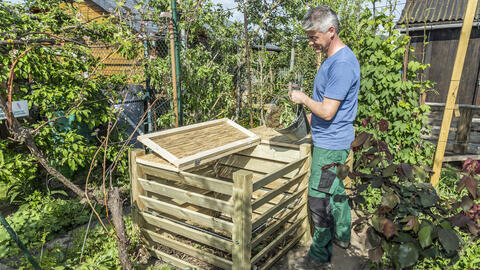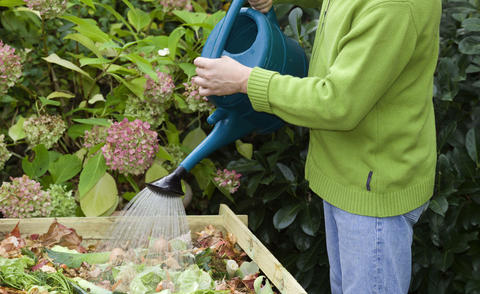Proper Composting: 7 Tips For Perfect Results
Composting garden and kitchen waste properly will provide you with valuable fertilizer for your plants. With these tips, you’ll soon have the gardener’s black gold.

When properly composted, plant waste turns into a valuable, natural fertilizer over time
How do I compost correctly? More and more hobby gardeners who want to create valuable humus from their plant waste are asking this question. Ripe compost, gardener’s black gold, is particularly popular when preparing beds in the spring. And plants also look forward to the natural fertilizer during the growing period - be they vegetables, fruit or decorative plants. You can expect fresh compost after just six weeks in an optimum rotting process; the valuable humus soil develops after the sixth month.
- Find the ideal spot for your compost
- Choose the correct waste
- Finely chop the material
- Ensure a balanced mix
- Ensure perfect moisture
- Be conscious of using additives
- Turn compost regularly
The compost location is pivotal for proper composting. A semi-shady place is perfect, for example under a deciduous tree or bush. Make sure that the compost pile is not exposed to blazing sunlight - as otherwise the material will quickly dry out. At the same time, some light protection from precipitation is recommended so that the material does not become completely soaked during rainy periods. The compost needs soil as a foundation. Otherwise the tiny creatures such as earthworms cannot get in.
All plant garden and kitchen waste that is not significantly impregnated with harmful substances is generally suitable as material for the compost. This generally includes grass clippings, cut branches, withered plant parts, vegetable and fruit remains. Coffee and tea filters as well as eggshells are also highly suitable compost materials. The peels of southern fruits such as bananas or oranges can be composted in small amounts. However, plant parts that are infested with certain pathogens such as clubroot or fire blight present a problem. These are better disposed of in the household refuse.

Another important point: The smaller the material is chopped, the more quickly the rotting process will be. It is worthwhile to put woody waste such as branches and twigs in particular through a garden chipper first. “Silent chippers” have proven effective. Chipping breaks up the wood fibers so that microorganisms can penetrate more easily and destroy the material. Bulky material is best cut down to a size of around 1.97 to 3.94 inches - so that it is still big enough to ensure sufficient aeration in the compost. You can chop up foliage, for example, with a lawnmower.
The garden chipper is an important companion for all garden lovers. We test nine different devices for you in our video.
It’s all about the mix! Every gardener who wants to compost properly should remember this saying. Because the microorganisms involved in the rotting process enjoy a good supply of nutrients from as diverse a range of raw materials as possible. It is important to ensure that the compost contains a balanced mix of wet, green material, and dry, woody parts. While lawn cuttings provide lots of nitrogen (N), for example, the woody material and foliage supply the microorganisms in particular with carbon (C). You can either stack the different materials in thin layers or mix them together and add to the compost.
The perfect moisture balance also plays a decisive role when composting. On one hand, tine creatures need sufficient water to be active at all. On the other, the rotting material may not become too moist as otherwise there will be a lack of air and the compost mass may putrefy. As a rule of thumb: The compost should only be as wet as a wrung out sponge. If it does not rain for a long period, it is advisable to moisten the compost with rainwater. In heavy rain you should cover it with protective compost fleece, straw or reed mats.

Compost starters are not generally necessary with a balanced material mix, however they can be helpful for improving the rotting process. Organic gardeners like to use extracts of wild herbs such as stinging nettles to harmonize the freshly piled compost. A few spadefuls of mature compost or garden soil can also be mixed in to get the rotting process off to a good start. The tiny creatures in this serve as a kind of “seed material” for the new compost. If you want you can also spread mineral compost accelerator over the waste.
Even if it takes some effort: Turning and loosening the compost once or twice a year is also important if you want to compost properly. Because turning moves the material from the edges to the middle, where the rotting process is most intensive. It also improves the aeration and there are fewer low oxygen areas in the compost. Early spring is recommended as the first time to turn in the year. The rotting stage can be checked with a simple cress test.



